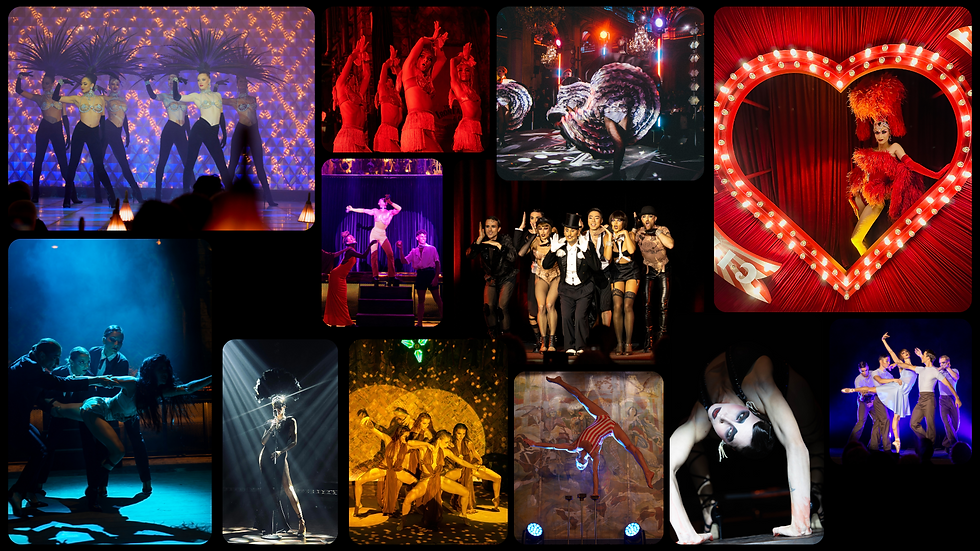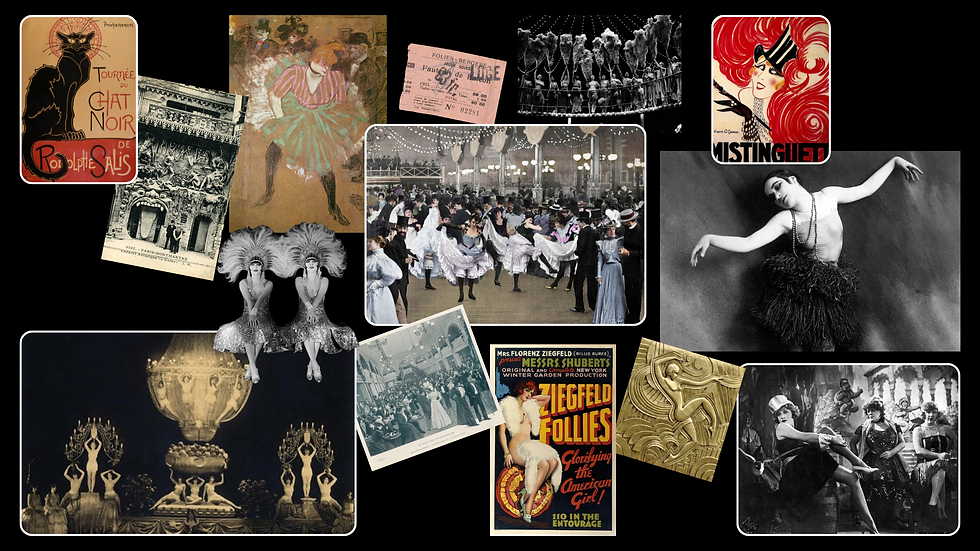CABARET: A GENRE, A PLAYGROUND, AN EXPERTISE
- gabriel ribeiro
- Jun 26
- 4 min read
Updated: Jun 27

CABARET, TOO OFTEN REDUCED TO A SINGLE IMAGE
Red feathers. Corsets. Cancan.
This is often the image that comes to mind when we mention the word "cabaret." An image we know well, having experienced it in the grand Parisian venues. While we cherish this heritage, we also recognize how this vision can seem static.
In event briefs, it frequently reappears under titles like "Parisian night" or "Moulin-style." A visually effective shortcut, but one that conceals a much broader, richer, and freer reality.
Because no, cabaret is not a gimmick.
It's a full-fledged art form.
A space for creation, freedom, and constant reinvention.
And that's precisely what we advocate at RêvARTe.

AT RêvARTe: CABARET AS A FIELD OF INVENTION
We've danced it, dressed it, lived it — at the Lido, the Folies Bergère, at the heart of the grandest venues.
But it was upon leaving that we understood its potential.
What we champion at RêvARTe is a living, intelligent, contemporary cabaret.
A cabaret that respects its codes — rigor, elegance, variety — while skillfully subverting them.
La JOÏA Cabaret embodies this vision :
A couture, joyful, contemporary, original, show.
With La JOÏA, we delight in blending everything we've learned from the cabaret world with new and unexpected influences. A free homage to Parisian revues, but with a twisted aesthetic, sensory storytelling, and a desire to surprise. An approach where the artists' talent inspires us to create new forms where cabaret can evolve through fresh perspectives.
Fun fact:
3 of RêvARTe's 4 founders and the director of La JOÏA hail from the Lido de Paris. Now transformed into a theater, it was once a temple of luxury cabaret. Together, they accumulate tens of thousands of shows and a rare knowledge of the stage.
WHERE DOES CABARET COME FROM?
Originally, cabaret was a social space: people drank, talked, sang. As early as the 17th century, Parisian chroniclers mentioned places where one might encounter both Jean Racine and bar brawls.
But its modern artistic form emerged in the late 19th century in Montmartre. Le Chat Noir, founded in 1881 by Rodolphe Salis, invented a new format: a mix of poetry, song, shadow theater, and satire. The tone was bohemian, engaged, often irreverent.
A few years later, the Folies Bergère offered variety shows combining dance and circus arts—not quite cabaret, more akin to a café-concert, marking the beginnings of a genre. It was at the Moulin Rouge that cabaret truly exploded. The venue became emblematic of a festive, flamboyant Paris in full transformation. There, we discover La Goulue,
Jane Avril, Valentin le désossé — figures who became mythical, immortalized by Toulouse-Lautrec. The artist turned them into icons, capturing their gestures, freedom, and provocation.
Cabaret then became more than just entertainment: it became a mirror of its era, a visual and social manifesto of the Belle Époque, with its momentum and excesses.

AND ELSEWHERE?
In Germany, during the 1910s–30s, Berlin cabarets stood out for their political bite. Schall und Rauch, Kabarett der Komiker, and Haus Vaterland became centers of a more direct, often subversive cabaret, influenced by expressionist cabaret and Dada movements. Figures like Claire Waldoff, Marlene Dietrich, Ernst Busch, Kurt Tucholsky, and Friedrich Hollaender emerged—artists who would leave a lasting legacy.
Across the Atlantic, the Ziegfeld Follies (1907–1931) drew inspiration from the Folies Bergère to create glamorous, grandiose revues, featuring "Ziegfeld Girls" adorned in cascades of rhinestones and feathers.

Did you know?
The Folies Bergère inspired the Ziegfeld Follies — which, in turn, laid the foundations for Broadway.
A FORM WITH A THOUSAND FACES
Unlike opera or theater, cabaret follows no fixed structure. It can be:
Grandiose (Friedrichstadt-Palast in Berlin) or intimate (Chez Michou, 75 seats).
Narrative (like Jean Paul Gaultier's Fashion Freak Show) or fragmented (as in the iconic “Mon truc en plumes” by Zizi Jeanmaire, recently reprised by Lady Gaga).
Precisely choreographed (Lido de Paris, Crazy Horse) or improvised (as at Madame Arthur).
Burlesque, absurd, lyrical, engaged, sensual, pictorial… or all of the above.
It encompasses dance, song, speech, stand-up, circus, drag, video projection, costume — even haute couture (Mugler or Jeremy Scott now rival Erté and Bob Mackie…).
ICONS OF THE GENRE
Cabaret allows for reinvention — every night, every decade, every stage. A few examples (non-exhaustive list!):
Joséphine Baker: From her banana belt to the grand staircase of Bobino, a complete artist and a figure of the resistance.
Zizi Jeanmaire: From the Paris Opera to revues created by Roland Petit, she embodies the ballerina turned revue leader.
Frédéric Rey: A dancer with a sculptural physique, spotted by Mistinguett at 17, initially a soloist at the Folies Bergère, later a renowned transformist in Jean-Marie Rivière's revues.
Dita Von Teese: A contemporary reinvention of burlesque, blending pin-up, chic cabaret, and visual performance.

CABARET, TAKEN SERIOUSLY
At RêvARTe, we believe cabaret is a creative space as free as it is rigorous. That it can be all at once: spectacular, intelligent, humorous, sensitive, provocative.
And that it deserves to be conceived in line with its heritage.
So yes, you can still request a “feathers and cancan” evening — But you can also say: “Take cabaret and give it a new angle.”
And that's where we truly come into play.
SEE MORE ON INSTAGRAM
Want to explore your version of cabaret with us?
And to go further,
get in touch.
Dreaming isn’t enough.
Producing cabaret is a craft.
It’s ours.
Images : Pinterest, RêvARTe Entertainment & La JOÏA Cabaret, Archives personnels













Comments